Physical Address
304 North Cardinal St.
Dorchester Center, MA 02124
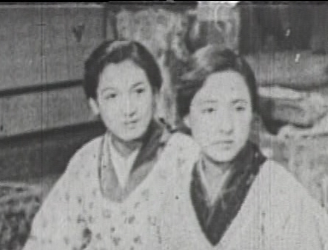
The Crown of Life (alternate English title)
| Production Company | Nikkatsu Tamagawa (Chōfu) |
| Scenarist | Yagi Yasutarō |
| Source | Yamamoto Yūzō (play) |
| Cinematographer | Yokota Tatsuyuki |
| Performers | Oka Jōji (Arimura Kotarō); Takihana Hisako (Masako, his wife); Izome Shirō (Kinjirō, his younger brother); Hara Setsuko (Ayako, his younger sister); Miake Bontarō (Katayanagi Genji); Izawa Ichirō (Kitamura Hideo) |
| Status | About 55 percent extant |
| Photography | Black and White |
| Sound | No (Note: Benshi narration in included on the DVD) |
| English Subtitles | No |
| Original Release Date | June 4, 1936 |
| Length | 54 minutes (originally 94 minutes) |
“Two brothers run a factory canning crabs. The elder brother Kotarō is righteous and insists on honesty. The younger brother is fixated on money. They are polar opposites. When a boat sails out looking for crab and does not return one day, the brothers begin to argue over how to run their facility. They had just received a large order from a foreign country and had obtained a loan from a lender that needed to be repaid.”
– From the Internet Movie Database (contributor: “Aghaemi”)
Hara Setsuko was the most iconic actress in the history of Japanese Cinema, establishing herself as a powerful symbol of Japanese womanhood throughout almost all of her 28-year career and for decades after her retirement. She is also one of the best-known Japanese actresses outside Japan, particularly for her six films with Ozu Yasujirō (which includes the so-called “Noriko trilogy,” consisting of Late Spring (Banshun, 1949), Early Summer (Bakushu, 1951) and Tokyo Story (Tokyo Monogatari, 1953)) and her two films for Kurosawa Akira (No Regrets for Our Youth (Waga seishun ni kuinashi, 1946) and The Idiot (Hakuchi, 1951)). She made more than a hundred movies – including memorable films for Naruse Mikio, Yoshimura Kisaburō and Inagaki Hiroshi – before she left the industry forever in 1963. Thereafter, Hara, who never married, led a totally private life in Kita-Kamakura under her birth name (Aida Masae), refusing all requests for interviews or photographs – a reclusiveness which led to her being called “the Greta Garbo of Japan.” She died in 2015, age 95.
Oka Jōji was a leading actor in the 1930s who became a character actor during the postwar years. During the late silent era of Japan, he appeared prominently in Ozu’s crime drama Dragnet Girl (Hijōsen no onna, 1933) and Naruse’s No Blood Relation (Nasanunaka, 1932). For non-Japanese movie fans, his most famous role is as the villain in the 1959 science fiction film Yūsei ōji (dir. Wakabayashi Eijirō), released in the US in 1962 as Prince of Space, which was lampooned in a 1997 episode of Mystery Science Theater 3000. Oka died in 1970.
Yagi Yasutarō was Uchida’s chief screenwriter in the 1930s, and was also a prominent scriptwriter in the postwar era for a number of distinguished directors. For Uchida, he wrote or co-wrote the acclaimed films Theatre of Life: Youth Version (Jinsei gekijō – Seishun hen, 1936, partially extant); The Naked Town (Hadaka no machi, 1937, lost); Unending Advance (Kagirinaki zenshin, 1938, partially extant) and Earth (Tsuchi, 1939, partially extant). His final script for Uchida was A Hole of My Own Making (Jibun no ana no nakade), released during the latter’s comeback year, 1955. He also scripted or co-scripted the recently re-discovered 1940 Korean film, Tuition (Jugyōryō, directed by Bang Han-jun and Choi In-kyu), as well as films for directors Imai Tadashi – The Rice People (Kome, 1957) and A Story from Echigo (Echigo Tsutsuishi Oyashirazu, 1964) – Shindo Kaneto – Lucky Dragon No. 5 (Daigo Fukuryu-Maru, 1959) – and Suzuki Seijun – Kantō Wanderer (Kantōmushuku, 1963). He died in 1987.
(Note: I’ve included several screenshots of the film even though the print is exceptionally poor, the worst I’ve seen for an Uchida film. I ask the reader’s pardon for this flaw.)
Let’s take a deep breath and say it: Crown of Life is a fairly boring movie. Some of it is very strikingly shot, true, and at odd times it’s even beautiful, but it’s not involving. The good news is that this is literally the only Uchida-directed film that I’ve seen about which I can truly say I was never emotionally engaged. Because I haven’t seen this film with subtitles, and have no idea what the benshi on the DVD soundtrack is saying, I suppose it could be argued that I don’t really have the right to judge it. But there are no subtitles for my DVD of Uchida’s Sweat (Kigeki: Ase, 1929) either, yet I can enjoy that comedy to a limited degree. I’m fairly sure that if the print of this film included subtitles, I’d still not enjoy it very much.
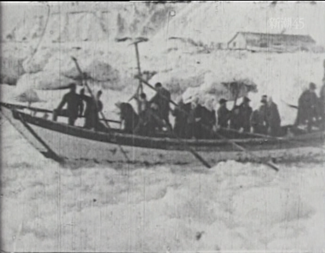
The most fascinating thing about the film, visually speaking, is the documentary footage of crab fishing and crabmeat canning that occasionally interrupts the narrative. These raw, exciting images may or may not have been filmed by Uchida himself: the visual look of this footage is utterly different from the studio footage.1 These scenes reveal the strong influence of Soviet Cinema, of which we can be reasonably sure that Uchida was well aware by this time. (He would later teach Soviet editing techniques in China.)
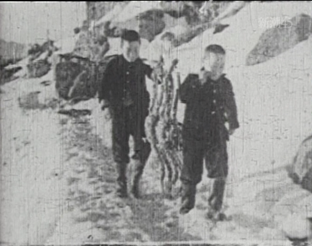
One particular shot of a couple of small boys carrying two enormous crabs from a pole hoisted on their shoulders is perhaps the single most memorable image in the entire film. (There are also some interesting shots of the crab canning process itself.) If it were not for this often compelling material, I probably would have given the film a 5 (i.e., “failure”) rating on IMDB.
The movie’s (relative) dullness is particularly unfortunate, because it’s the only film Uchida ever made in which he cast the great Hara Setsuko, who plays the hero’s young sister. (Clearly, the only reason that this super-obscure work was released on DVD in Japan at all is because Hara was in it.) In 1937, Hara switched studios, moving from Uchida’s studio at the time, Nikkatsu, to Toho. This is a shame, because she would have been ideally cast as the daughter in Uchida’s Unending Advance.

Crown of Life was filmed a year after Hara’s debut and a year before her star-making role in the infamous propaganda picture Daughter of the Samurai (a.k.a., The New Earth; Atarashiki tsuchi, 1937), co-directed by Itami Mansaku and the Nazi filmmaker Dr. Arnold Fanck, but the maturity and power she would demonstrate in the later film is nowhere in evidence here. In this picture, the teenage Hara is merely a pretty ingénue, trying perhaps a bit too hard to convey her character’s conventional emotions of worry, concern and grief. (Furthermore, the surviving fragment is more than half over before Hara’s face is even clearly seen.) From this performance alone, it would have required a critic of genius – indeed, a world-class prophet – to predict that she’d one day become a major star, never mind the most celebrated avatar of Japanese (cinematic) femininity ever.
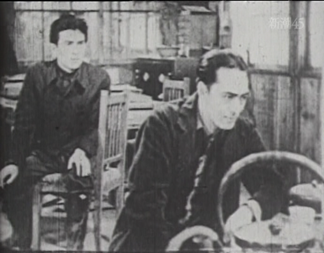
The biggest problem with the movie is that although it’s about two brothers who love and respect each other yet hold very different philosophies of life and business, Uchida doesn’t seem, at this point in his career, to know how to effectively dramatize such a conflict visually. In the first scene in the brothers’ house, the older brother, Kotarō, takes center stage while the younger one, Kinjirō, hovers in the background, and we keep waiting for the latter to assert himself, but he never does in a way that would make the scene interesting.
As Uchida would do so often in his later work, he’s filled this set with many realistic details. But it feels too much as if we’re watching a play (which this material originally was) rather than a movie. He hadn’t yet mastered the cinematic rendering of dramatic material that distinguishes such later films by this lifelong fan of theater as Chikamatsu’s Love in Osaka, Hero of the Red-Light District and (especially) The Mad Fox.
The film is, to put it mildly, definitely “unrestored”: the quality of the print is atrocious, with outrageous surface dirt, wear and tear and frequent fading of the image. This sense of decay paradoxically makes the shots displaying, say, crab-fishing boats plowing through wintry seas more powerful, because the scratches and dirt accentuate the harshness of the environment depicted. But the poor print makes the scenes filmed in the studio far less powerful than they would otherwise be.
It has occurred to me that this movie may have been originally shot as a sound film, but the print that happened to survive had been distributed as a silent picture to provincial movie houses not yet wired for sound. Certainly, 1936 is a very advanced date – even in Japan, a late-adopter of sound film technology – for a major studio in that country to release a silent movie. By that year, even conservative Ozu, with his classic The Only Son (Hitori Musuko), had embraced talkies.
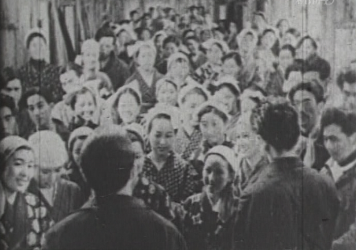
I have called the studio scenes generally uninteresting, but there are a number of shots that are exceptions to this rule, mainly those that involve the canning factory’s (mostly) female workforce. There’s a very nice moment late in the narrative in which the brothers, with their backs to the camera, are addressing the workers and the camera slowly rises to show row upon row of the women listening to their message. Although Uchida doesn’t use depth-of-field photography (the women at the back appear much less clear than those in front), it’s still an impressive shot. And there’s a scene of the women running out of the factory and through the streets that is filmed from below, giving them a sense of dynamic monumentality, like the heroic workers of Soviet films of the period.
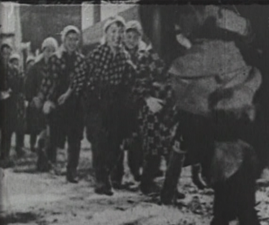
So it’s quite amazing, after seeing so many other works by this great artist, to watch this quite stagey and static film – though containing, as I have said, individual shots of great power and beauty – and think, “This very flawed but still watchable work is the weakest Uchida movie I’ve ever seen.”
In the final scene, the feuding brothers, now reconciled, are talking to one another when the younger brother notices a painting in the background, and draws the other family members’ attention to it. (It appears to be a picture of a crab, but I can’t really make it out.) When I first saw the movie, as the younger brother talked and laughed, I kept expecting to see a close-up of this picture, since it’s so central to the scene, but Uchida never provided one. A small glitch, perhaps, but symbolic of the frustrating experience of watching this strange and somewhat disappointing movie.
A slow, static drama, with some occasionally very interesting documentary and staged footage.
(Note: as of early 2022, I’m the only one who has rated this film on IMDB.)
None.